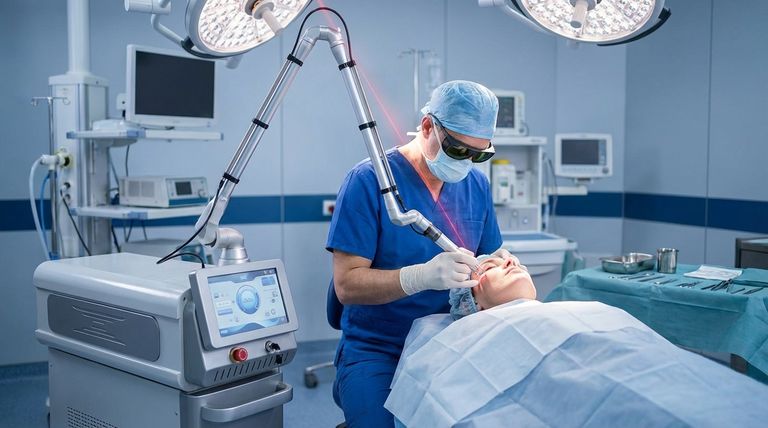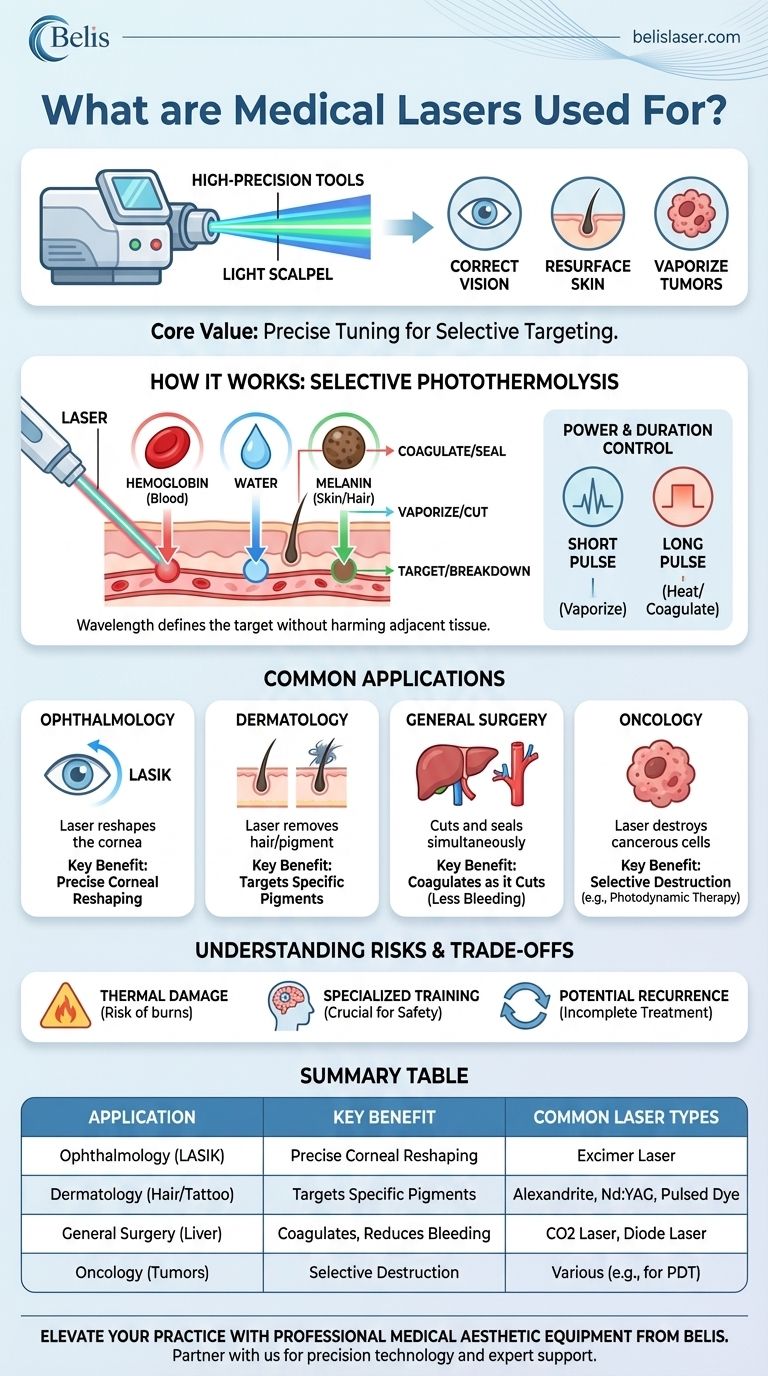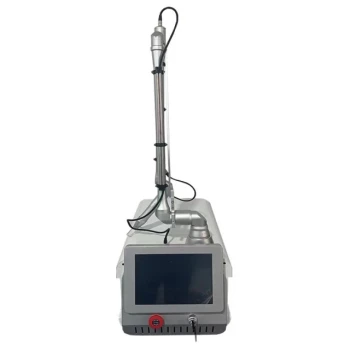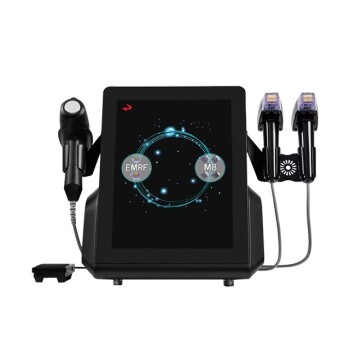In medicine, lasers are used as high-precision tools for a vast range of surgical and therapeutic procedures, from correcting vision and resurfacing skin to vaporizing tumors and sealing blood vessels. They function as a highly focused "light scalpel," allowing surgeons to perform complex tasks with remarkable control, often resulting in less bleeding, reduced post-operative pain, and faster healing compared to traditional methods.
The core value of a medical laser is not the light itself, but its ability to be precisely tuned. By adjusting the laser's wavelength and power, a surgeon can selectively target and affect specific biological tissues—like water, blood, or pigment—while leaving surrounding areas virtually untouched.

How Medical Lasers Fundamentally Work
A medical laser is far more than a simple beam of light. It is a device that generates a highly concentrated, single-wavelength beam of energy. This controlled energy is the key to its medical utility.
The Principle: Selective Photothermolysis
The foundational concept behind most medical laser procedures is selective photothermolysis. This means using a specific wavelength of light (photo) to heat (thermo) and destroy (lysis) a chosen target without harming adjacent tissue.
The laser's light energy is absorbed by a target molecule in the body, known as a chromophore. Common chromophores include water, hemoglobin (in blood), and melanin (in skin and hair).
The Mechanism: Wavelength Defines the Target
Different laser wavelengths are absorbed by different chromophores. This is the crucial element that makes lasers so versatile.
A laser targeting hemoglobin, for example, will be strongly absorbed by blood vessels, causing the blood to heat up and coagulate (seal). This is why laser surgery involves significantly less bleeding. A different laser targeting water can vaporize soft tissue, effectively cutting or ablating it layer by layer.
The Effect: Power and Duration Control the Outcome
Beyond wavelength, the surgeon controls the laser's power and the duration of each pulse. Short, high-energy pulses can vaporize tissue, while longer, lower-energy pulses can gently heat it to stimulate collagen production or coagulate blood.
Common Applications Across Medical Fields
The ability to precisely target different tissues makes lasers an indispensable tool across numerous specialties.
In Ophthalmology: Correcting Vision
Perhaps the most well-known use is in vision correction surgery like LASIK. Here, an excimer laser, which is absorbed by water, precisely reshapes the cornea by vaporizing microscopic amounts of tissue, thereby changing its focusing power.
In Dermatology: Treating Skin
Dermatologists use various lasers to treat a wide array of conditions. Lasers can remove unwanted hair by targeting melanin in the hair follicle, erase tattoos by breaking up ink pigments, or resurface wrinkled skin by stimulating collagen growth.
In General Surgery: The "Light Scalpel"
In the operating room, lasers are used as a scalpel for delicate procedures. Their ability to coagulate blood vessels as they cut makes them ideal for surgeries in blood-rich organs like the liver, reducing blood loss and the need for transfusions.
In Oncology: Destroying Tumors
Lasers can be used to destroy cancerous and precancerous growths by vaporizing them. In a technique called photodynamic therapy, a patient is given a light-sensitive drug that accumulates in cancer cells, and a laser is then used to activate the drug, selectively killing the malignant cells.
Understanding the Trade-offs and Risks
While highly effective, laser surgery is a powerful tool that requires skill and carries its own set of considerations. The phrase "with proper use" is critical.
The Risk of Thermal Damage
The primary risk is unintended thermal damage. If the wrong power or wavelength is used, or if the operator is not sufficiently skilled, the laser's heat can spread to and damage healthy tissue adjacent to the target, potentially causing burns or scarring.
The Importance of Specialized Training
A laser is only as good as the surgeon wielding it. Extensive, specialized training is required to understand the complex physics of light-tissue interaction and to execute procedures safely and effectively. Patient outcomes are directly tied to the practitioner's expertise.
Potential for Incomplete Treatment or Recurrence
In applications like tumor removal or tattoo removal, there is a risk that not all target cells or pigments will be destroyed. This can lead to the recurrence of the condition, requiring further treatment sessions.
Making the Right Choice for Your Procedure
Deciding if a laser procedure is the best option depends entirely on the medical goal, the specific condition being treated, and a thorough discussion with a qualified expert.
- If your primary focus is minimal recovery time and precision: Laser surgery often excels due to its ability to reduce bleeding and collateral tissue damage, which can lead to faster and less painful healing.
- If you are treating a surface-level condition (e.g., on the skin or eyes): Lasers offer unparalleled control for targeting specific pigments or microscopic layers of tissue that are inaccessible to a traditional scalpel.
- If you are considering a major internal surgery: Discuss with your surgeon whether the benefits of a laser (e.g., reduced blood loss) for your specific case outweigh the potential risks and costs compared to conventional techniques.
Ultimately, a medical laser is a sophisticated tool whose value is unlocked by the knowledge and skill of the professional using it.
Summary Table:
| Application | Key Benefit | Common Laser Types |
|---|---|---|
| Ophthalmology (e.g., LASIK) | Precise corneal reshaping | Excimer Laser |
| Dermatology (e.g., hair removal, tattoo removal) | Targets specific pigments (melanin, ink) | Alexandrite, Nd:YAG, Pulsed Dye |
| General Surgery (e.g., liver surgery) | Coagulates blood vessels as it cuts, reducing bleeding | CO2 Laser, Diode Laser |
| Oncology (e.g., tumor destruction) | Selective destruction of cancerous cells | Various (e.g., for Photodynamic Therapy) |
Elevate Your Practice with Professional Medical Aesthetic Equipment from BELIS
As a clinic or premium beauty salon specializing in advanced treatments, you understand that superior outcomes depend on precision technology and expert skill. BELIS provides state-of-the-art medical lasers designed for reliability, safety, and exceptional results in procedures like skin resurfacing, hair removal, and surgical applications.
Our equipment empowers practitioners to offer treatments with minimal downtime, reduced bleeding, and enhanced patient satisfaction. Partner with BELIS to access cutting-edge technology backed by expert support.
Contact our specialists today to discover the right laser solutions for your clinical needs and enhance your service offerings.
Visual Guide

Related Products
- Fractional CO2 Laser Machine for Skin Treatment
- Fractional CO2 Laser Machine for Skin Treatment
- Pico Picosecond Laser Machine for Tattoo Removal Picosure Pico Laser
- Hydrofacial Machine with Facial Skin Analyzer and Skin Tester
- Q Switch Nd Yag Laser Machine Tattoo Removal Nd Yag Machine
People Also Ask
- What is a fractional CO2 laser machine used for? A Guide to Advanced Skin Resurfacing
- How often should you do fractional CO2 laser? The 4-6 Week Rule for Optimal Results
- Is CO2 laser for all skin types? A Critical Guide to Skin Type Safety and Risks
- What are the advantages of laser in the medical field? Precision, Recovery, and Drug-Free Solutions
- Who is not suitable for CO2 laser? Key Risks for Darker Skin & Active Conditions



















